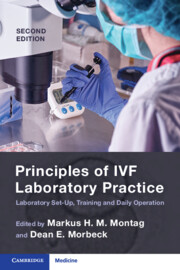Book contents
- Principles of IVF Laboratory Practice
- Principles of IVF Laboratory Practice
- Copyright page
- Contents
- Contributors
- Foreword
- The Evolution of IVF Practice
- Section 1 Starting a New Laboratory and Training Protocols
- Section 2 Pre-procedure Protocols
- Section 3 Gametes
- Section 4 Insemination/ICSI
- Section 5 Fertilization Assessment
- Section 6 Embryo Assessment: Morphology and Beyond
- Section 7 Embryo Cryopreservation
- Section 8 Embryo Transfer
- Chapter 39 Routine Embryo Transfer in the IVF Laboratory
- Section 9 Quality Management
- Index
- References
Chapter 39 - Routine Embryo Transfer in the IVF Laboratory
from Section 8 - Embryo Transfer
Published online by Cambridge University Press: 07 August 2023
- Principles of IVF Laboratory Practice
- Principles of IVF Laboratory Practice
- Copyright page
- Contents
- Contributors
- Foreword
- The Evolution of IVF Practice
- Section 1 Starting a New Laboratory and Training Protocols
- Section 2 Pre-procedure Protocols
- Section 3 Gametes
- Section 4 Insemination/ICSI
- Section 5 Fertilization Assessment
- Section 6 Embryo Assessment: Morphology and Beyond
- Section 7 Embryo Cryopreservation
- Section 8 Embryo Transfer
- Chapter 39 Routine Embryo Transfer in the IVF Laboratory
- Section 9 Quality Management
- Index
- References
Summary
The final critical step in the IVF process is the embryo transfer. Trans-vaginal embryo transfer, often combined with abdominal ultrasound guidance, returns embryos to the woman’s uterus with the goal of implanting into the uterine wall and creating a pregnancy leading to live birth. Successful embryo transfer depends on the protocols of the clinic, development of the embryos in culture, and optimized preparation of the uterine lining. Embryos can be fresh or frozen–thawed, with or without biopsy for genetic testing, at time of transfer. Good embryo transfer technique is required from both the clinician and the embryologist. In all cases, a fine sterile flexible plastic catheter designed for embryo transfer is loaded with the embryos by the embryologist and handed off to the clinician for insertion into the patient’s uterus. Methods of catheter loading and hand-off to the clinician will be discussed, as well as troubleshooting notes.
- Type
- Chapter
- Information
- Principles of IVF Laboratory PracticeLaboratory Set-Up, Training and Daily Operation, pp. 287 - 292Publisher: Cambridge University PressPrint publication year: 2023



